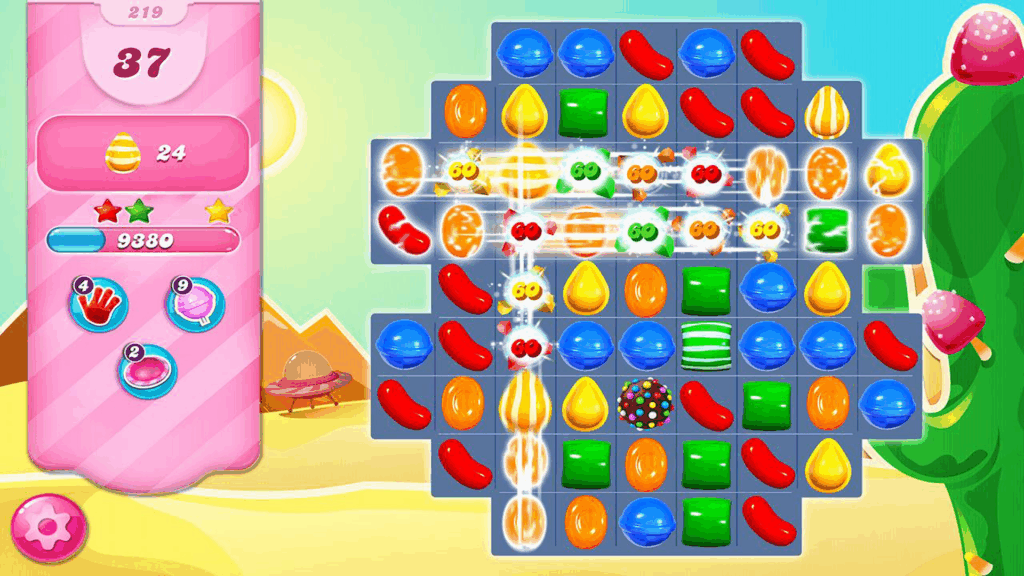Anúncios
Few mobile games have achieved the iconic status of Candy Crush.
What started as a simple match-three puzzle game has evolved into a global phenomenon, captivating millions of players worldwide and redefining the mobile gaming industry.
Anúncios
But how did this colorful, candy-filled adventure go from a small concept to one of the most successful mobile games in history?.
In this exploration, we’ll uncover the origins of Candy Crush, tracing its humble beginnings at King (the developer behind the game) and examining the innovative mechanics that set it apart.
Anúncios
From its addictive gameplay loops to its clever monetization strategies, Candy Crush not only dominated app stores but also created a blueprint for success in the casual gaming market.
We’ll also take a closer look at how the game’s design and frequent updates kept players engaged over the years.
Whether through new levels, limited-time challenges, or social integrations, Candy Crush mastered the art of retention in a competitive and ever-changing landscape.
Join us as we dive deep into the strategies, psychology, and cultural impact of one of the most addictive games ever made. Discover what makes Candy Crush more than just a game—it’s a case study in digital entertainment, marketing brilliance, and sustained success.
Tracing the Origins of Candy Crush: How a Simple Concept Became a Global Phenomenon
The Humble Beginnings: A Spark of Sweet Inspiration
The story of Candy Crush Saga begins in 2012, when the gaming company King, then a relatively modest player in the mobile gaming industry, decided to test an experimental idea. Mobile gaming was still carving out its space as a serious contender in the gaming world, and King was eager to step up its game.
The goal was to create something simple yet irresistibly engaging—a formula that would appeal to both casual and seasoned players. Enter Candy Crush, a game that would eventually become one of the most beloved and addictive puzzles of all time.
Inspired by the match-three puzzle concept—similar to games like Bejeweled—Candy Crush built on a familiar mechanic but added its own twist: a sugary, candy-themed aesthetic that felt nostalgic and playful. Early developers prioritized the game’s accessibility, ensuring that even those new to mobile gaming could pick it up and play within seconds.
The idea was to design something intuitive yet packed with strategic depth, a balancing act that would prove critical to its success.
Little did the team at King know, their creation would not only capture the attention of gamers but would also revolutionize the way people viewed mobile entertainment. Candy Crush didn’t just launch as a game; it became a cultural touchstone, spreading like wildfire across demographics, from teenagers waiting for the bus to retirees lounging on their couches.
The Key Ingredients: What Makes Candy Crush So Addictive?
At the heart of Candy Crush’s success lies its unique design choices, each carefully crafted to hook players. One of the most notable features is its use of progression-based gameplay.
Players are given a set number of moves to complete a level, and while the early stages are relatively simple, the difficulty ramps up over time. This creates a feedback loop of challenge and reward that keeps users coming back for “just one more try.”
The candy-themed visuals and cheerful sound effects are another key ingredient. Bright colors and satisfying animations make every move feel rewarding, tapping into the human brain’s love for sensory gratification.
The game also uses clever psychological tactics, such as intermittent rewards and limited lives, which keep players emotionally invested.
Losing all your lives doesn’t just end the game; it forces you to take a break, creating a sense of anticipation for when you can play again.
Then there’s the social aspect. Candy Crush was one of the first mobile games to fully integrate with social media platforms like Facebook, allowing players to send and receive lives or compete on leaderboards. This social connectivity not only boosted player retention but also turned Candy Crush into a viral sensation, as users encouraged friends and family to join the fun.
The Evolution of Candy Crush: From Casual Game to Multimedia Empire
Expanding the Candyverse: Sequels, Spinoffs, and New Features
As the original Candy Crush Saga climbed the charts, King realized the potential to expand its sugary empire. In the years following its debut, the game spawned a series of sequels and spinoffs, including Candy Crush Soda Saga, Candy Crush Jelly Saga, and Candy Crush Friends Saga.
Each variation introduced new gameplay mechanics, from fizzy soda bottles to adorable jelly queens, while maintaining the core match-three format that fans loved.
These spinoffs allowed King to keep the franchise fresh and appealing, catering to different player preferences while retaining the familiar charm of the original. For instance, Candy Crush Soda Saga introduced the concept of liquid-filled levels, adding a new layer of strategy, while Candy Crush Jelly Saga emphasized boss battles against AI opponents.
These innovations not only kept longtime players engaged but also attracted new audiences curious to explore the expanding “Candyverse.”
In addition to new games, King also rolled out regular updates to the original Candy Crush Saga, including themed events, limited-time challenges, and special rewards. These updates kept the game dynamic and relevant, ensuring that even veteran players always had something new to look forward to.
From Mobile Screens to Global Screens: Candy Crush as a Cultural Icon
The success of Candy Crush didn’t just stop at gaming; it transcended into pop culture. Over the years, the game has made appearances in TV shows, advertisements, and even live events.
It became a household name, recognized not just by players but also by those who had never picked up a mobile game in their lives. Candy Crush was no longer just a pastime; it was a cultural phenomenon.
In 2017, the franchise took another ambitious leap with the launch of “Candy Crush: The Game Show,” a live-action competition series that aired on CBS. This move showcased the brand’s versatility and its ability to adapt beyond the confines of digital entertainment.
The show brought the game’s colorful aesthetic to life, complete with giant candy props and real-life puzzles, further cementing its status as a multimedia powerhouse.
The game also inspired merchandise, from phone cases to plush toys, allowing fans to take their love of Candy Crush into the real world. This cross-media presence not only strengthened the brand but also highlighted its far-reaching influence, proving that Candy Crush was more than just a game—it was a global sensation.
The Psychological Pull of Candy Crush: Why We Can’t Stop Playing
The Science of Satisfaction: How Candy Crush Triggers Our Brains
One of the reasons Candy Crush is so addictive lies in its ability to tap into the brain’s reward system. Each time a player matches three candies, their brain releases a small dose of dopamine, the “feel-good” neurotransmitter. This creates a sense of achievement and pleasure, encouraging players to keep going to experience that rush again.
But it’s not just the immediate rewards that keep players hooked; it’s also the game’s clever use of uncertainty. Candy Crush employs what psychologists call a variable reward system, where the outcome of each move is unpredictable.
Will this cascade of candies clear the board or leave you one step short of victory? This unpredictability keeps players on their toes and makes every match feel exciting.
The game also uses loss aversion to its advantage. When players are just one move away from completing a level but run out of moves, they’re often tempted to purchase extra lives or boosters. This taps into our natural dislike of losing, making us more likely to invest time (or money) to avoid failure.
The Role of Community: How Candy Crush Connects Players
While Candy Crush is primarily a solo experience, its social features have played a significant role in its longevity. From the very beginning, the game encouraged players to connect with friends on Facebook to share lives or compete for the highest scores.
This sense of community added a layer of camaraderie to the game, turning it into a shared experience rather than an isolated one.
King has also fostered a sense of belonging through in-game events and challenges. These limited-time activities often encourage players to work together to achieve collective goals, such as unlocking special rewards or completing a particularly difficult level.
This collaborative aspect not only strengthens player engagement but also creates a sense of purpose, making Candy Crush feel like more than just a game—it’s a community.
By combining addictive gameplay mechanics with a strong sense of social connection, Candy Crush has managed to stay relevant in an ever-changing gaming landscape. Its ability to evolve while retaining its core appeal is a testament to its enduring charm and the brilliant minds behind its creation.

Conclusion: The Sweet Legacy of Candy Crush’s Global Success
Candy Crush Saga is far more than just a mobile game; it has become a cultural and entertainment powerhouse that redefined the boundaries of casual gaming. From its humble beginnings in 2012 as a simple yet engaging puzzle game, Candy Crush has transformed into a global phenomenon, captivating millions across all age groups.
Its unique combination of visually appealing graphics, strategic gameplay, and psychological triggers has created an addictive formula that continues to delight players over a decade after its launch.
The game’s evolution into a multimedia empire, with sequels, spin-offs, and even a television game show, demonstrates its adaptability and enduring appeal. King’s commitment to innovation, from introducing new gameplay mechanics to fostering community-driven events, has ensured that the Candy Crush experience remains fresh and relevant. Moreover, its seamless integration of social features has turned a solo puzzle game into a shared global experience, cementing its role as a social connector in the gaming world.
In the end, Candy Crush Saga is more than a game—it’s a testament to the power of creativity, psychology, and community. As it continues to evolve, one thing is clear: the sweet success of Candy Crush has secured its place as an iconic piece of gaming history, loved by millions around the world.






